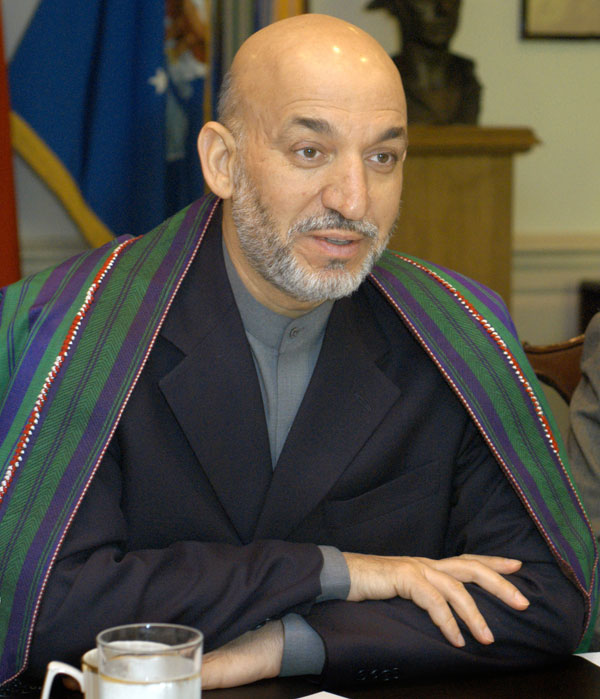Karzai Seeks ‘Civilian Surge’ Likely Beyond U.S. Capacity
The number of civilian experts Afghanistan officials believe are necessary for counterinsurgency efforts looks to exceed what Obama can send.
Jul 31, 2020584.7K Shares10.8M Views
Afghan Presisent Hamid Karzai (U.S. Dept. of Defense)
The Afghan government will ask the Obama administration to send up to 700 civilian advisers to Afghanistan, a figure that threatens to exceed the administration’s available crop of civilian governance and development experts, according to a document that President Hamid Karzai will present this week to President Barack Obama.
Earlier this year, the Obama administration asked top-ranking officials in the Karzai government to come up with a list clarifying the areas in which it needed U.S. assistance to increase its ability to govern competently. Expanding the capacity of the Afghan government to provide for its civilians is a key component of the counterinsurgency strategy that the administration adopted for Afghanistan in March. The Afghan government has responded with what it calls its “Civilian Surge Plan,” which it says will, over time, “reduce [popular] support for insurgency, make foreign assistance more effective and ultimately reduce the need for foreign aid.”
Illustration by: Matt Mahurin
The document, finalized on April 21, presents a “total of 676 requests for technical advisors from 22 Government Ministries.” Positions would be based in the capital, Kabul, as well as out in the provinces, where the Afghan government has had a difficult time consistently providing services for its citizens. The technical assistance the Afghan government seeks are for a wide variety of government services, from agricultural assistance to civil engineering to medicine to social work. Those figures may be a requirement floor, not a ceiling, according to the document, which says its requests are “preliminary and can be expected to change in response to changing needs and additional information received from ministries.”
Some of the requests for advisers appeared to reflect Afghan priorities that the Obama administration has criticized. The Civilian Surge Plan calls for eight advisers across two ministries for anti-corruption efforts, as corruption has emerged as one of the most endemic weaknesses of the Afghan government. Yet for one agency, the Independent Directorate of Local Governance, the plan calls for 34 advisers for “public relations and donor coordination” and three more for “strategic communication and information management.” That figure is also greater than the 21 advisers sought for the Ministry of Counter-Narcotics, despite the central role drugs play in funding Afghan insurgent groups.
In keeping with the recommendation that the advisory program be focused on long-term results, the plan proposes to create a management structure for the advisers jointly administered by the U.S., the United Nations’ mission to Afghanistan and the Afghan Finance Ministry.
While Afghan officials familiar with the plan did not expect the Obama administration to be the sole provider of the 676 technical advisers — the need is described as one for the international community to fill — one said that the United States would “likely provide a good number of them,” since it was the Obama administration that came up with the idea for a “civilian surge” of governance and development advisers to supplement the 17,000 new troops it has sent to Afghanistan. The “Civilian Surge Plan” is a response to a request from the Obama administration to identify areas of assistance, made during February’s trilateral talks between the U.S., Afghan and Pakistani governments in Washington. Karzai and his Pakistani counterpart, Asif Ali Zardari, will meet Obama on Wednesday for the second round of talks.
The Obama administration has found that its desire to send civilian governance and development experts to Afghanistan exceeds its ability. In March, State Department spokesman Robert Wood saidthe department had only identified 51 additional civilian personnel it could send to Afghanistan as part of a “ramp up” of its efforts in Afghanistan for a “wide range of activities.” The State Department has not traditionally maintained a corps of governance experts that can deploy to the outskirts of foreign countries on short notice, and its efforts at constructing one over the past four years have been arduous. Last month, Pentagon spokesman Geoffrey Morrell acknowledgedthat the administration was looking to find as many as 300 military reservists to bolster the State Department’s deployable personnel out of “a realization that they are not going to be able to provide the ‘civilian surge’ in the near future and the need is now.” Such a total would still fall short of the needs identified by the Afghan government.
The disparity between the numbers of civilian advisers the Afghan government says it needs and the capacity of the U.S. government to fill those positions is a longstanding frustration of the community of counterinsurgency theorist-practitioners, several of whom occupy prominent roles in the Obama Pentagon. Many have cheered the creation of the State Department’s Office of Stabilization and Reconstruction, which has taken the lead in identifying civilian personnel from across the government who can be deployed to assist the military with nation-building or stability operations. Yet a recent report by the National Defense University found that the U.S. still “manifestly lacks adequate civilian capacity to conduct complex operations,” largely due to underfunding. It recommended building a corps of “5,000 deployable, active-duty government civilians” who can be sent to assist with governance and development efforts in war-torn or failing states in short order.
“My understanding is that the need for that capacity is pretty widely recognized,” said Dan Langberg, a deputy director of the Project on National Security Reform, an effort to restructure the national-security apparatus to better balance civilian and military resources for missions like counterinsurgency. “The question is who’s going to do it — our military or our civilians? There are several reasons, and at the top of them is cost, for why we should have civilians doing the job.”
In addition to more civilian advisers, the Afghan government is seeking to change the structure of those already in place. The Civilian Surge Plan derides the “short-term contracts” according to which foreign advisers typically leave Afghanistan as soon as they develop an understanding of “an incredibly complex society, culturally different from much of the developed world.” It recommends that advisers “live under circumstances that maximize their day-to-day interaction with the people of Afghanistan.” It specifically “recommend[s] against” the use of the mixed military and civilian units known as Provincial Reconstruction teams. Instead, it wishes the advisers to embed not with U.S. military units but with representatives of the Afghan ministries.
Advisory work “must be seen as an extension of the government NOT as increased foreign presence,” the Civilian Surge Plan reads, “and must work within Afghan structures on priorities.”
Representatives from the State and Defense Departments did not return requests for comment by press time. Nor did representatives from NATO countries that have both troops and civilian advisers in Afghanistan.

Hajra Shannon
Reviewer
Hajra Shannona is a highly experienced journalist with over 9 years of expertise in news writing, investigative reporting, and political analysis.
She holds a Bachelor's degree in Journalism from Columbia University and has contributed to reputable publications focusing on global affairs, human rights, and environmental sustainability.
Hajra's authoritative voice and trustworthy reporting reflect her commitment to delivering insightful news content.
Beyond journalism, she enjoys exploring new cultures through travel and pursuing outdoor photography
Latest Articles
Popular Articles

